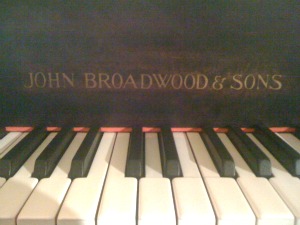During the recording sessions for Nico Muhly’s Drones & Piano, sometimes the piano bench squeaked. “Bench was loud,” I said, after a particularly squeaky take. Through my earbud, I heard the voice of engineer Paul Evans. “I rather like it,” he said. Paul wasn’t being entirely serious, but he was hinting (or poking fun?) at an approach to recording that resembles Dogme 95 or “Remodernist” films. As high technology allows us to achieve recordings of greater and greater surface perfection, maybe we don’t want it.
I was recording at Valgeir Sigurðsson’s Greenhouse Studios on the outskirts of Reykjavik. It’s a carefully curated studio where Bedroom Community‘s recordings are made. There’s very high technology there. At the same time, the overall aesthetic values the “human” — with attendant quirks and imperfection.
 A few weeks before the recording sessions, I emailed Valgeir to ask what kind of piano would be in the studio. “Not a ‘concert piano’ by any means,” he responded, “but a charmingly characterful dirty old thing.” He was describing an antique Broadwood grand, fully functioning, and with a particular clarity or edginess of attack. The piano is heard in other recordings of Nico’s music, and much else.
A few weeks before the recording sessions, I emailed Valgeir to ask what kind of piano would be in the studio. “Not a ‘concert piano’ by any means,” he responded, “but a charmingly characterful dirty old thing.” He was describing an antique Broadwood grand, fully functioning, and with a particular clarity or edginess of attack. The piano is heard in other recordings of Nico’s music, and much else.
It caused me to realize that all my commercial recordings until now were made using Steinway Ds — the 9-foot concert grand pianos that are a contemporary-classical-music-culture-constant. There are subtle differences among Steinways, but I’d never recorded with anything else.
Live music making is an important ingredient in most recordings. How much to smooth and regularize? How much to conceptualize or apply post-performance insight?
Dave Hickey maintains that good rock music engages us because of many levels of fault. “Glitch music” can be based on errors, unwanted artifacts from recordings — fleeting accidents cherished. Simple or elaborate cooking can make things delicious. At least sometimes, some foods taste better raw.

Sometime ago, when I used to try adapt the punk/New Wave/Bowie Berlin period mentality to classical music, I often thought about this. However I am not sure it works in a classical music context; rock music (which I like very much as well) comes from a different place. Roughly played rock music works, but I am not sure about the classical music equivalent.
Because for many years I earned my living playing for dance companies (and also middle of the road music) on some terrible pianos, or good pianos that were not maintained, the idea of only playing Steinway Ds sounds like paradise to me!
When I was young, my piano teacher would insist to only play piano recordings from vinyl records. CDs were readily and widely available, but she liked the “rawness” and “imperfections” of the record. So, we’d start the record and I coudl hear the creaks, cracks, buzz, and pops of the record. She loved it, and I think it is quite endearing. Sometimes it is hard to let go of old ways.
I love this! Since pianists rarely carry around their own instruments, the Steinway has become a standard sound, part of an unquestioned language. So many pivotal recordings were made on unique, special instruments, it’s the sound that lays an aesthetic and emotional foundation for the work, whether that sound comes from the instrument, the mics, the moaning Gould, or your squeaking bench.
SOUND!!
I had an ear-opening experience in verismo recording many years ago when I made a disc of Schubert and Mendelssohn fantasies on an 1829 Conrad Graf at the Frederick Collection in Ashburnham, Massachusetts, about an hour west of the New England Conservatory on US Route 2. It was a constant challenge to get takes that minimized the various creaks and squeaks emanating from this remarkable piece of early nineteenth-century technology — the pedals were especially problematic. At times, the frustration level was high, but I learned a great deal about the music and about old pianos that I could not have learned by cruising through the project on a D. BTW, my most recent disc was done on a Shigeru Kawai EX.